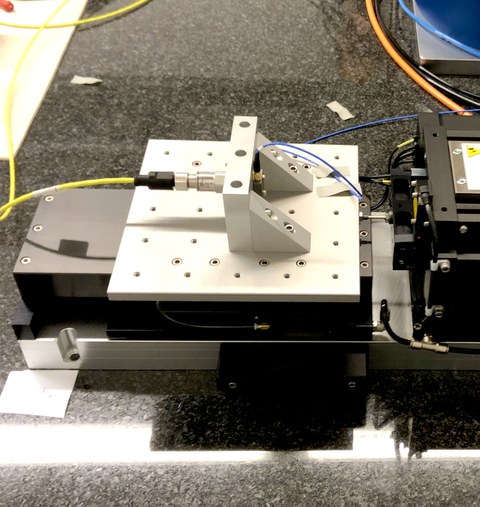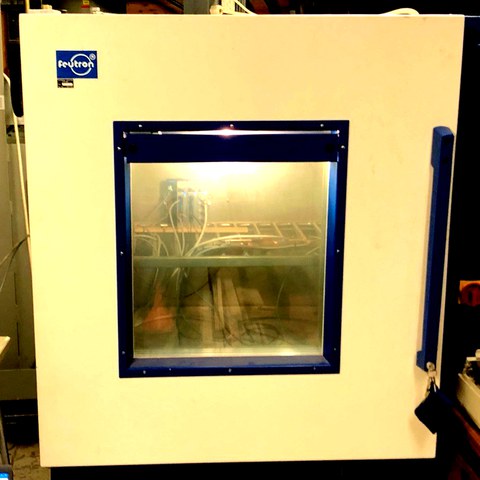Robuste, lifetime monitoring concepts
Table of contents
Project data
| Titel | Title TP C01: Robuste lebensdauerumfassende Monitoringkonzepte für Offshore-Windenergieanlagen | Project C01: Robuste lifetime monitoring concepts for offshore wind turbines Förderer | Funding Deutsche Forschungsgemeinschaft (DFG) / SFB 1463 Zeitraum | Period 01/2021 – 12/2024 |
Report from year book 2023
Reliable aging – dynamics of uncertainties in measurement systems

Examined acceleration sensors using low-frequency calibration station at BAM
Project C01 within the Collaborative Research Center 1463 (CRC 1463) aims to develop reliable measurement systems for civil engineering structures over several years. The challenge lies in the fact that measurement systems exhibit uncertainties that increase over time, making it difficult to reliably identify damages to the structure.
In 2023, the research focused on the time-invariant transmission behavior of acceleration sensors in the low-frequency vibration range and the time-invariant measurement uncertainty budget of strain gauges. Laboratory experiments at TU Dresden revealed that acceleration sensors are primarily influenced by systematic parameters. In the low-frequency vibration range, sensitivity decreases with decreasing vibration frequency. Temperature also affects sensitivity, it increases with rising temperatures. For strain gauges, both systematic influences (temperature and humidity) and random influences (cable length, cable quality, measurement circuit, type of measurement module) were identified which contributing to the measurement uncertainty budget. The experimental data were evaluated under the assumption of linear, time-invariant systems.
Additionally, strain gauges were subjected to aging cycles in a climate chamber, revealing significant aging effects after six months. Observable were measurement drifts and increases in standard deviation. A mathematical model, derived from the data, is intended to assess the reliability of measurement systems in the future. If the measurement value exceeds a threshold due to drift or increased standard deviation, compensation measures such as reapplication of sensors or analytical compensation through Bayesian updating are necessary.
The completed laboratory experiments are now under analysis, with a focus on developing an evaluation concept that distinguishes between measurement system aging and structural damage.
Report from year book 2022
Uncertainty as a quality characteristic of monitoring systems

Applied single strain gauges on the INVAR specimen
The project C01 within the Collaborative Research Center 1463 (CRC 1463) aims to collect reliable information from wind turbines over a period of several years. The problem is that measurement systems have measurement uncertainties that increase over time. The measurement systems therefore become increasingly unreliable and a change in the structure can no longer be reliably identified.
In order to describe the increase in measurement uncertainty with numbers, laboratory tests with typical measurement systems are carried out at TU Dresden. In 2022, mainly laser triangulation sensors were investigated, which allow a contactless distance measurement. For this purpose, time-independent experiments were carried out first, which served as basis for comparison. In the further course of the experiments, aging effects were simulated within a climate simulation chamber, which were initiated by controlled temperature and humidity phases. After a few months of testing, the first signs of aging within the measurement system were already apparent, which were reflected in the successive increase in measurement uncertainty. Furthermore, the system response of the monitoring system to different temperatures was described by a temperature-dependent transfer function. This mathematical model does not accurately
represent reality, especially when the monitoring system ages. For this reason, a so-called Bayesian model updating was implemented, which updates the model parameters with time and thus enables a continuous adaptation of the mathematical model. The real data are used to adapt the mathematical model to the real monitoring system’s behavior. This helps the practicing engineer in the real-time evaluation of the structure as the compensation of the aging measurement system is automated.
Further research efforts include strain gauges. Here, not only the entire monitoring system is to be investigated with regard to its measurement uncertainty, but the influence of individual components (sensor, cable, measurement amplifier) is to be quantified.
Report from year book 2021
Monitoring systems also age

Preliminary tests with strain gages in the climate chamber
The project C01 is another research project, which is part of the Collaborative Research Center 1463 (CRC 1463). The scope of the project is in the field of structural monitoring of wind turbines. The overall goal of developing a digital twin for wind energy systems is conceived in the context of real-time monitoring of support structures. The digital twin is essentially based on the coupling of real subcomponents of the wind turbine and their digital representatives that must represent the real structure as accurately as possible. The essential information for this must be obtained via monitoring systems that guarantee a lifelong link between the real and virtual systems.
In the project being worked on at the TUD, the goal is to research methods for a monitoring concept that encompasses the entire service life of the structure – with the knowledge that both the real load-bearing structure and the load actions change over the course of time. The problem is that monitoring systems are also subject to an ageing process. The output of the measuring system deteriorates over its lifetime in terms of data quantity and quality. The difficulty is that components of the measuring system do not fail completely immediately. Therefore, the success of the research depends on whether initial uncertainties and ageing processes of the measurement systems can be taken into account and compensated.
In this context, preliminary tests were carried out for the probabilistic description of the transfer function of different sensor types (strain gauges, accelerometers and laser distance sensors) and the associated measurement system components. The measured values were evaluated with respect to their temperature and humidity dependence so that initial time-independent transfer functions could be approximated.
In the further course, time-dependent tests will be carried out in order to be able to describe the ageing processes of further measuring system components (sensor, cable, measuring amplifier).
